|
Issue
#2 SB - 13 | 09 - 15
September | Lyon, France.
|
|
Wednesday
13 September 2000
|
| Tuesday
12 September 2000 |
|
|
|
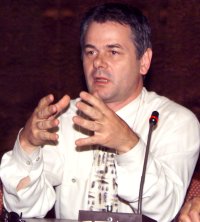 Title:
The cost of, and potential for, reducing carbon emissions in the
European Union and US - implications for domestic policy and international
negotiations Title:
The cost of, and potential for, reducing carbon emissions in the
European Union and US - implications for domestic policy and international
negotiations
Sponsors: International Project for Sustainable Energy Paths
(IPSEP) and the European Business Council for Sustainable Energy
(e5)
Contact: Florentin Krause <ipsep@igc.org>
Internet: http://www.ipsep.org
/ http://www.e5.org
The
United States can achieve most of its Kyoto Protocol commitments
through domestic action, at a net economic benefit to the tune of
$48 billion in 2010. That was one of the findings presented by Dr.
Florentin Krause, IPSEP (photo right), during this special presentation
of new economic research findings on how the European Union and
the United States can cut carbon emissions while making money. The
event was chaired by Paul Metz of e5.
Challenging
the conventional wisdom that climate change economics must be addressed
from a burden sharing perspective, Krause demonstrated how the US
and EU could shift to a benefit sharing approach through investment-led
productivity growth, using: domestic transformation reforms that
reduce transaction costs and other market barriers; domestic fiscal
reforms to tackle the deadweight losses arising from taxes and subsidies;
and international emissions trading. He explained that the economic
benefits would include total factor productivity gains from energy
efficiency investment, policy-induced reductions in technology costs,
and lower pre-tax fossil fuel prices. Summarizing his research findings,
Krause said the US could achieve 63% of its Kyoto commitments through
domestic action by 2010 at a net economic benefit of $48 billion,
and 90% of its commitments by 2020 at a net benefit of $108 billion.
He said the EU could go even further, achieving benefits equivalent
to 2% of the EU's GDP.
Describing
the flexibility mechanisms as over-rated, he found that a least
cost approach could reduce the significance of global trading by
a factor of ten. Concluding, he described how developing countries
also have a stake in domestic OECD no regrets action.
Rob
Bradley, Climate Network Europe, wondered why the European Union
had not taken up the kind of approach outlined by Krause, such as
tackling subsidies for fossil fuel and shifting the burden of taxation
away from labour and onto sources of pollution. He accused the European
Commission of pursuing an ambiguous approach.
Discussion:
The European Commission panelist, Peter Zapfel, told a Greenpeace
representative that he believed it was possible to address climate
change without the construction of 80 new nuclear power plants in
Europe.
More
information: The IPSEP study, "Energy Policy in the Greenhouse"
is available in PDF format at www.ipsep.org
Related
links: Climate Network Europe: www.climnet.org
|
|
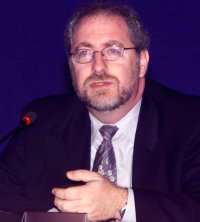 Title:
Experiences and methodologies of technology transfer programmes
Sponsors: International Energy Agency (IEA), Climate Technology
Initiative (CTI) Title:
Experiences and methodologies of technology transfer programmes
Sponsors: International Energy Agency (IEA), Climate Technology
Initiative (CTI)
Contact: Debra Justus <debra.justus@iea.org>
Internet: http://www.climatetech.net
Abraham
Haspel (photo right), CTI, explained that the Initiative aims
to foster international cooperation for accelerated development
and diffusion of climate-friendly technologies and practices. Developing
countries and transitional economies are invited to formulate a
technology assessment exercise, or CTIP. The program's focus is
on country-driven plans for action and implementation. Private sector
involvement is deemed crucial, Haspel noted, and the host country
may have to adapt its domestic regulatory framework to enable private
sector investment.
Norbert
Nziramasanga, on behalf of the Southern Africa Development Community
(SADC), emphasized that his project experience shows that broad
support from all stakeholders is required, and sometimes patience
needs to be exercised.
David
Hales, USAID, emphasized the United States' commitment to help
developing countries reduce greenhouse emissions. He stressed that
an enabling environment in the host country is needed, although
donors should not dominate the process.
Speakers
were in general agreement that projects need to be country-driven,
private sector involvement is key, and cultural and language barriers
may exist.
Discussion:
A panel of experts noted that much valuable experience is currently
being gathered, and that technology transfer is moving away from
the traditional model and towards a new era of sharing technology
and know-how, where there is no question of 'one-size fits all'.
|
|
Title:
Business views on fast-tracking the CDM approval process
Sponsors: U.S. Business Council for Sustainable Energy (BCSE)
& European Business Council for a Sustainable Energy Future (EBCSEF)
Contact: Lisa Jacobson <ljacobson@bcse.org>
Internet: U.S. Business Council for Sustainable Energy: http://www.bcse.org
Michael
Marvin,
BCSE, introduced the event on business views on fast-tracking the
CDM approval. Panelists addressed the benefits of supporting the
EU proposal for a positive list of eligible CDM projects.
Panel
I: Benefits and leading proposals to fast-track the CDM:
John Palmisano, Palmisano & Associates, argued that the benefits
of an early start for the CDM include generating information on
costs, institutions, transactions, capacity building needs and unintended
consequences. He advocated a learning-by doing approach that might
help prompt ratification of the Protocol.
 Lisa
Jacobson, BCSE, outlined approaches to fast-tracking CDM project
approval, such as the adoption of emissions performance benchmarks
and thresholds for the size of projects, while excluding requirements
such as additionality and baseline determination. Lisa
Jacobson, BCSE, outlined approaches to fast-tracking CDM project
approval, such as the adoption of emissions performance benchmarks
and thresholds for the size of projects, while excluding requirements
such as additionality and baseline determination.
Jos
Delbeke (photo right), European Commission, presented the European
Union proposal for a positive CDM list designed to reduce uncertainties.
The proposal would designate a list of safe, environmentally sound
projects based on renewable energy sources, energy efficiency improvement
and demand-side management approaches to energy and transport. Wytze
van der Gaast, Joint Implementation Network, cautioned that
the proposal could be time consuming.
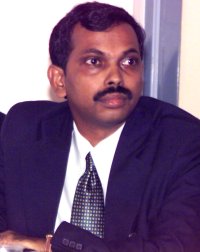 Panel
II: Developing country views and project case studies: Panel
II: Developing country views and project case studies:
Dr. Coto, Fundacion Solar, recalled the lessons from aggregating
electrification projects in Central America. He suggested that such
projects, such as biogas generation, which may not be funded by
the private sector, should be considered under the CDM. Dr. Ramana,
Winrock International, India, highlighted the differences in scale
between renewable energy projects and CDM requirements, stressing
the importance of bundling projects to reduce transaction costs.

Panel
III: Industry and environmental views:
Jorge Barrigh, Ballard Generation Systems, argued for clear
terminology in the context of the CDM. Dr. Tod Delaney, First
Environment, Inc., supported the EU proposal, arguing that it would
enable strategic decision-making, shorten the project cycle time,
and help developing countries' institutions to develop CDM policies.
Liam Salter, World Wide Fund for Nature (WWF), stressed the
importance of domestic action in order to prevent free riders from
"hijacking" projects. On the inclusion of sinks under the CDM, the
WWF stated that the risks far outweigh the benefits.
Related
links: http://www.jiqweb.org
; http://www.winrock.org
; http://www.panda.org
|
|
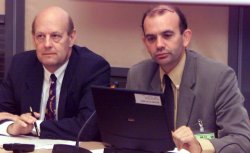 Title:
Quantifying Kyoto - Impact of the options in the draft negotiating
texts Title:
Quantifying Kyoto - Impact of the options in the draft negotiating
texts
Sponsors: The Royal Institute of International Affairs (RIIA)
with the World Bank, the Institute for Global Environmental Strategies
(IGES) and the Royal National Institute of Public Health and the
Environment (RIVM)
Contact: Christiaan Vrolijk <cvrolijk@riia.org>
Internet: www.riia.org
The
sponsors of this event presented results from an expert workshop,
Quantifying Kyoto, convened earlier this year to consider the different
dimensions of flexibility in the Kyoto Protocol and to assess their
likely combined impact. The presentations covered the likely 'demand'
from OECD countries; the impact of various restrictions on use of
the mechanisms; and the various sources of supply of credits.
 Christiaan
Vrolijk, RIIA (photo left), outlined the main aims and questions
for participants. The results summarized in the table show that
the overall impact remains highly uncertain. The first presenter,
Michael Grubb, (photo above, seated right) showed wide-ranging
results from economic models, and contrasted these against (mostly
lower) projections in national communications to the FCCC. He concluded
that a reasonable planning range, assuming a modest degree of domestic
action within OECD countries, would be for demand in the region
300-700MtC/yr average during the commitment period. The second presenter,
Erik Haites, FCCC (photo above, seated left), showed results
illustrating that the most important influences on compliance costs
for the OECD would be availability of pre-2008 credits on the CDM,
restrictions on the mechanisms, restrictions on 'hot air' sales,
and the strength of a compliance/liability regime. Transaction costs
and charges on the mechanisms had much a lower impact. Christiaan
Vrolijk, RIIA (photo left), outlined the main aims and questions
for participants. The results summarized in the table show that
the overall impact remains highly uncertain. The first presenter,
Michael Grubb, (photo above, seated right) showed wide-ranging
results from economic models, and contrasted these against (mostly
lower) projections in national communications to the FCCC. He concluded
that a reasonable planning range, assuming a modest degree of domestic
action within OECD countries, would be for demand in the region
300-700MtC/yr average during the commitment period. The second presenter,
Erik Haites, FCCC (photo above, seated left), showed results
illustrating that the most important influences on compliance costs
for the OECD would be availability of pre-2008 credits on the CDM,
restrictions on the mechanisms, restrictions on 'hot air' sales,
and the strength of a compliance/liability regime. Transaction costs
and charges on the mechanisms had much a lower impact.
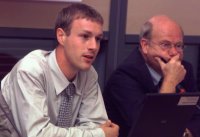 Finally,
Bert Metz, RIVM, (photo left, seated right) summarized the
workshop discussions on supply, using the expert assessment from
the earlier workshop as summarized in the table (right). The presenters
noted that at the mid- and higher end of these ranges, the availability
of credits might substantially exceed the demand from the OECD,
leading to a very low 'price of carbon' and little incentive for
domestic action in the OECD countries. Finally,
Bert Metz, RIVM, (photo left, seated right) summarized the
workshop discussions on supply, using the expert assessment from
the earlier workshop as summarized in the table (right). The presenters
noted that at the mid- and higher end of these ranges, the availability
of credits might substantially exceed the demand from the OECD,
leading to a very low 'price of carbon' and little incentive for
domestic action in the OECD countries.
More
information:
The
full papers of the workshop will be available on: http://www.riia.org/Research/eep/quantifying.html
A
brief summary will be published in the new journal, Climate Policy:
http://www.climatepolicy.com
A RIIA briefing paper will be available at COP-6.
|
|
Title:
Sinks in the Kyoto Protocol : carbon upset or carbon offsets? Lessons
learned from plantation projects
Sponsors: Friends of the Earth International (FoEI), KIKO Forum,
World Rainforest Movement (WRM), FERN
Contact: Yuri Onodera, Friends of the Earth (FoE) <yurio@iea.att.ne.jp>
Internet: http://www.foei.org
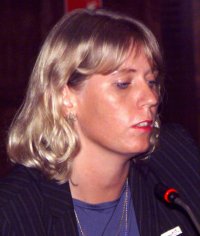 Introducing
the concept of tree plantations in the South, Larry Lohmann,
The Corner House, described plans to meet the Kyoto commitments
by planting trees as a neocolonialist concept that will reinforce
a system of inequalities. On carbon sink plantations, Jorn Stave,
NorWatch, described projects in Tanzania and Uganda. He highlighted
issues of permanence and leakage, and land tenure conflicts. Simone
Lovera, (photo left) Friends of the Earth Paraguay, referred
to a new FoEI, WRM and FERN report "Tree Trouble, A compilation
of testimonies on the negative impact of large-scale, monoculture
tree plantations prepared for COP-6 ". She stressed that a major
concern about these schemes is the undermining of the original funding
commitments to forestry initiatives agreed at UNCED in 1992. Sandy
Gauntlett, the International Research Institute for Maori and
Indigenous Education (IRI), spoke of the implications of plantations
for indigenous cultures around the world. He stated that prior to
tackling plantations and carbon sinks, NGOs and Indigenous People
Organizations (IPOs) must address the issue of global inequity.
Hendro Sangkoyo, Forum for Indigenous Peoples and Local Communities
on Climate Change, presented a position paper stating that as peoples
on the frontline of climate change impacts they have the right to
participate in the FCCC. On LULUCF he stressed concerns about the
profound implications of carbon sinks for land rights, and supported
the creation of an Adaptation Fund. Ricardo Carrera, (photo
below, seated right) in his concluding remarks, stated that sinks
are not a "breathing space" but may lead to the establishment of
millions of Eucalyptus plantations. Introducing
the concept of tree plantations in the South, Larry Lohmann,
The Corner House, described plans to meet the Kyoto commitments
by planting trees as a neocolonialist concept that will reinforce
a system of inequalities. On carbon sink plantations, Jorn Stave,
NorWatch, described projects in Tanzania and Uganda. He highlighted
issues of permanence and leakage, and land tenure conflicts. Simone
Lovera, (photo left) Friends of the Earth Paraguay, referred
to a new FoEI, WRM and FERN report "Tree Trouble, A compilation
of testimonies on the negative impact of large-scale, monoculture
tree plantations prepared for COP-6 ". She stressed that a major
concern about these schemes is the undermining of the original funding
commitments to forestry initiatives agreed at UNCED in 1992. Sandy
Gauntlett, the International Research Institute for Maori and
Indigenous Education (IRI), spoke of the implications of plantations
for indigenous cultures around the world. He stated that prior to
tackling plantations and carbon sinks, NGOs and Indigenous People
Organizations (IPOs) must address the issue of global inequity.
Hendro Sangkoyo, Forum for Indigenous Peoples and Local Communities
on Climate Change, presented a position paper stating that as peoples
on the frontline of climate change impacts they have the right to
participate in the FCCC. On LULUCF he stressed concerns about the
profound implications of carbon sinks for land rights, and supported
the creation of an Adaptation Fund. Ricardo Carrera, (photo
below, seated right) in his concluding remarks, stated that sinks
are not a "breathing space" but may lead to the establishment of
millions of Eucalyptus plantations. 
Discussion:
On efforts to move towards more sustainable land management systems
in the tropics, it was highlighted that governments are not regulating
the proliferation of large monoculture plantations. It was suggested
that a transparent CDM would need international socio-cultural standards.
More
information:
World Rainforest Movement: http://www.wrm.org.uy/
FERN: http://www.greennet.org.uk/fern/
|
|
 Title:
Design options for the CDM governance structure Title:
Design options for the CDM governance structure
Sponsor: Centre for Clean Air Policy (CCAP)
Contact: Catherine Leining <cleining@ccap.org>
Internet: http://www.ccap.org
Ole
Plougmann, (photo right, seated center), a delegate from Denmark,
explained that CCAP and the Foundation for International Environmental
Law and Development (FIELD) has sponsored the CDM Dialogue Group
to encourage informal discussions between developing and developed
countries.
The discussion outcomes were presented by Ned Helme, CCAP
(photo above, seated far left). He stressed the importance of streamlining
the governance process and the need for efficiency and cost effectiveness,
while maintaining the environmental integrity of CERs. Participants
agreed that the primary function of the COP/MOP should be the overall
design of the CDM and developing CDM policy. However, he explained,
less consensus exists on the depth of involvement of the Executive
Board (EB), on whether the Operating Entity (OE) should be a private
or government entity, and on the relation between the EB and OE.
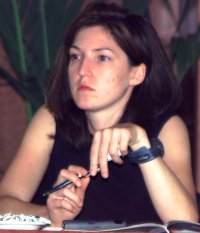 Agus
Sari, (photo above, seated right) a member of the Indonesian
delegation, urged greater public involvement in the discussion on
the CDM's governance. He also advocated a role for the public in
an appeals procedure linked to project approval. Agus
Sari, (photo above, seated right) a member of the Indonesian
delegation, urged greater public involvement in the discussion on
the CDM's governance. He also advocated a role for the public in
an appeals procedure linked to project approval.
On
deciding baseline methodologies, Jo Simons, (photo right)
United Kingdom delegation, expressed a preference for an IPCC assessment
of methodologies with final approval falling to the EB. She supported
the formation of a panel of experts accountable to the EB.
United
States delegate, Trigg Talley, noted that establishing baselines
in the US was a major policy challenge, and, while supportive of
IPCC's involvement, he emphasized that baselines remain a policy
issue.
Discussion:
Issues debated included lessons learned from the Montreal Protocol,
agreeing a positive list of clean technologies, accreditation of
the OE, and the prompt start of the CDM.
|
|
 Title:
Briefing: The International Emissions Trading Association (IETA)
position paper for COP-6 Title:
Briefing: The International Emissions Trading Association (IETA)
position paper for COP-6
Sponsors: The World Business Council for Sustainable Development
(WBCSD) in collaboration with the International Emissions Trading
Association (IETA)
Contact: Dave Moorcroft <moorcroft@wbcsd.ch>
Internet: http://www.wbcsd.org
; http://www.ieta.org
Introducing
the IETA as a new organization aiming to contribute to the debate
on the design and implementation of international rules and guidelines
for emissions trading, Andrei Marcu highlighted core activities.
These include information gathering and dissemination, capacity
building in developing countries and EITs and facilitation of business
partnerships.
Charlotte Grezo, BP, (photo above, seated right) utlined
the Proposal for a Carbon Trading Scheme in the UK developed by
the UK Emissions Trade Group. She highlighted the voluntary character
of the scheme, in which companies will participate if incentives
are available. The scheme aims to deliver post-Kyoto targets with
minimum impact on competitiveness and to be compatible with the
international ET rules.
Morten
Prehn Sorensen, Danish Energy Agency, reported that the Folketing
(parliament) approved Denmark's national ET scheme in 1999. The
scheme will help Denmark achieve national targets to reduce  emissions by 20%, compared to 1988 levels, by 2005. He noted that
the system sets quotas for emissions reductions from the electric
power sector.
emissions by 20%, compared to 1988 levels, by 2005. He noted that
the system sets quotas for emissions reductions from the electric
power sector.
Jos
Cozijnsen, The Netherlands, (photo above, seated left) delivered
a comparative study of ET systems in Europe. He noted that Denmark,
UK, the Netherlands and Norway had developed plans while the EU
had launched a discussion paper. Germany, Italy, Austria, and Belgium,
are focusing on partial aspects of ET systems such as taxation and
JI projects.
|
| The
Earth Negotiations Bulletin (ENB) on the side is
a special publication of the International Institute for Sustainable
Development (IISD) in cooperation with the United Nations Framework
Convention on Climate Change (UNFCCC) Secretariat. The Editor of ENB
on the side is Peter Doran Ph.D <peter@iisd.org>. This issue
has been written by Emily Boyd <E.Boyd@uea.ac.uk>, Hernan Lopez
LL.M. <hlopez@law.pace.edu> and Gerhard Mulder <gerhardmulder@hotmail.com
>. The Digital Editor is Kenneth Tong <ken@iisd.org>. Photos
by Leila Mead <leila@interport.net>. Funding for publication
of ENB on the side at SB-13 is provided by the UNFCCC Secretariat.
The opinions expressed in ENB on the side are those of the
authors and do not necessarily reflect the views of IISD and other
funders. Excerpts from ENB on the side may be used in non-commercial
publications only and only with appropriate academic citation. For
permission to use this material in commercial publications, contact
the Managing Editor at <kimo@iisd.org>. Electronic versions
of these issues of ENB on the side from SB-12 can be found
on the Linkages WWW server at http://enb.iisd.org/climate/sb13/ |
|


